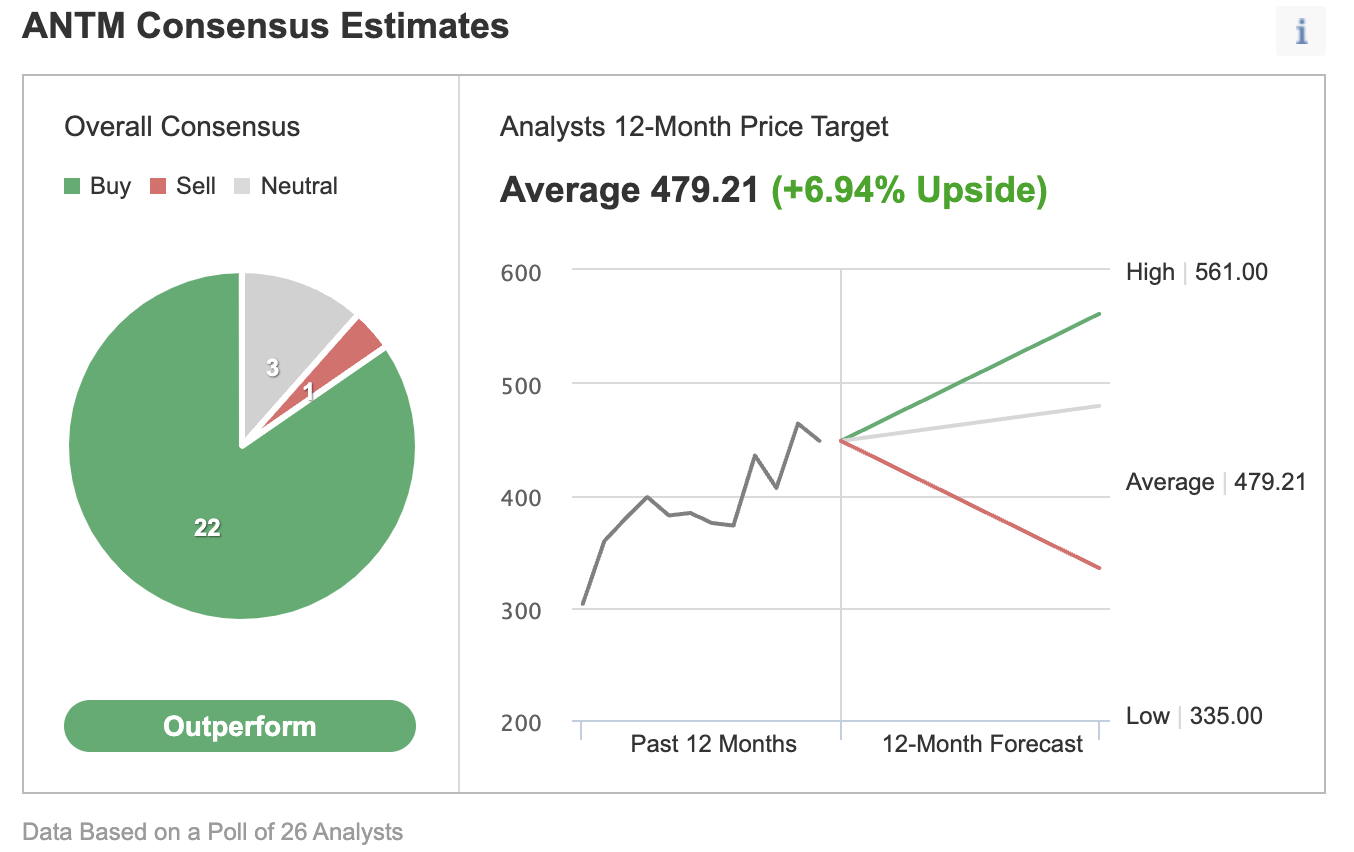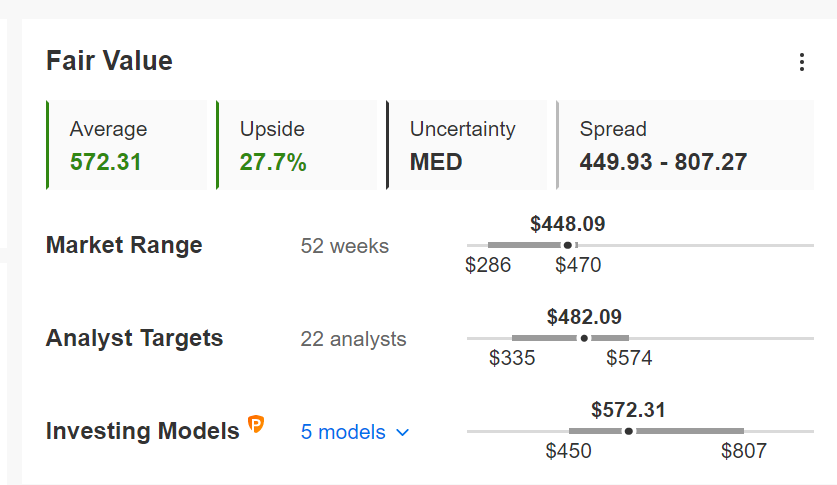- Health benefits group Anthem’s stock price is down more than 3.5% in 2022.
- ANTM stock is likely to stay volatile as management prepares to release Q4 earnings on Jan. 26.
- Long-term investors could consider buying the dip, especially if shares decline toward $430.
Investors in the health benefits giant Anthem (NYSE:ANTM) have enjoyed returns of 36.9% in the past 12 months. However, the new year has started on a more subdued note for ANTM—the stock is down 3.6%.

By comparison, the Dow Jones US Health Care Providers Index returned 18.2% in the past year, but has declined 6.4% year-to-date. Meanwhile, the Dow Jones US Insurance Index is up 31.5% in the past 52 weeks, and has returned 3.4% YTD.
On Dec. 30, ANTM shares went above $470 to hit a record high. But since then, shares have lost close to 5%. Anthem stock’s 52-week range has been $286.04 - $470.02, while the market capitalization stands at $108.4 billion.
Anthem, which provides health insurance, serves around 117 million people. It is one of the largest for-profit, managed healthcare companies in the US.
Management issued robust Q3 financials in late October. Operating revenue was $35.5 billion, up 16% year-over-year. Adjusted EPS came in at $6.79 vs. $4.20 achieved in Q3 2020. Cash and equivalents totaled almost $5.5 billion.
On the results, CEO Gail Boudreaux said:
"The strong growth we saw across all of our benefits business in the third quarter demonstrates that our core offerings, as well as additional innovative products and services, continue to resonate in the market.”
During the quarter, Anthem repurchased 1.2 million shares for $450 million. The weighted average price was $378.85. Meanwhile, management now expects adjusted EPS for 2021 to exceed $25.85. The health insurer is set to release its Q4 numbers on Jan. 26 before the open.
Prior to the release of Q3 metrics, ANTM stock was trading shy of $400. Then came the record high of $470.02 on Dec. 30. Now, Anthem shares are around $447.10, while the current price supports a dividend yield of 1.02%.
What To Expect From Anthem Stock
Among 26 analysts polled via Investing.com, ANTM stock has an “outperform" rating.

Chart: Investing.com
Analysts also have a 12-month median price target of $479.21 for the stock, implying an increase of about 7% from current levels. The 12-month price range currently stands between $335 and $561.
Similarly, according to a number of valuation models, like those that might consider P/E or P/S multiples, dividends or terminal values, the average fair value for ANTM stock via InvestingPro stands at $572.31.

Source: InvestingPro
In other words, fundamental valuation suggests shares could increase around 28%.
Meanwhile, we can look at Anthem’s financial health as determined by ranking more than 100 factors against peers in the healthcare sector. In terms of profit and price momentum, it scores 4 out of 5 (top score). But cash flow and growth stand at 3. Anthem's overall performance is rated “great.”
At present, P/E, P/B and P/S ratios for ANTM stock are 19.7x, 3.0x and 0.8x. By comparison, those metrics for its peers stand at 10.5x, 1.4x and 0.7X. Meanwhile, comparable numbers for UnitedHealth Group Incorporated (NYSE:UNH)—covered here—are 28.2x, 6.2x and 1.6x.
As we have already noted, Anthem is expected to issue Q4 metrics next week. Therefore, in the coming days, we expect ANTM stock to be choppy, and possibly come under pressure. It could potentially slide toward $430, after which it should trade sideways, possibly between $420 and $440.
Adding ANTM Stock To Portfolios
Anthem bulls with a two- to three-year horizon who are not concerned about short-term volatility could consider buying into the declines. The target would be $479.21, which is the analysts' consensus expectation.
Alternatively, investors could consider buying an exchange traded fund (ETF) that has ANTM as a holding. Examples would include:
- iShares U.S. Healthcare Providers ETF (NYSE:IHF)
- Invesco S&P 500® Enhanced Value ETF (NYSE:SPVU)
- T. Rowe Price Equity Income ETF (NYSE:TEQI)
- First Trust Rising Dividend Achievers ETF (NASDAQ:RDVY)
Finally, those who are experienced with options strategies and believe there could be further declines in Anthem shares during this earnings season might prefer to do a bear put spread.
Most option strategies are not suitable for most retail investors. Therefore, the following discussion is offered for educational purposes and not as an actual strategy to be followed by the average retail investor.
Bear Put Spread On Anthem Stock
Intraday Price: $447.10
In a bear put spread, a trader has a long put with a higher strike price as well as a short put with a lower strike price. Both legs of the trade have the same underlying stock (i.e. Anthem here) and the same expiration date.
The trader wants ANTM stock to decline in price. However, in a bear put spread, both the potential profit and the potential loss levels are limited.
Here's an example:
For the first leg of this strategy, the trader might buy an at-the-money (ATM) or slightly out-of-the-money (OTM) put option, like the ANTM March 18, 2022, 440-strike put option. This option is currently offered at $18.10. It would cost the trader $1,810 to own this put option, which expires in less than two months.
For the second leg of this strategy, the trader sells a put, like the ANTM March 18, 2022, 430-strike put option. This option’s current premium is $14.20. The option seller would receive $1,420, excluding trading commissions.
Maximum Risk
In our example, the maximum risk will be equal to the cost of the spread plus commissions. Here, the net cost of the spread is $3.90 ($18.10 – $14.20 = $3.90).
As each option contract represents 100 shares of the underlying stock, we’d need to multiply $3.90 by 100, which gives us $390 as the maximum risk.
The trader could easily lose this amount if the position is held to expiry and both legs expire worthless, i.e., if the Anthem stock price at expiration is above the strike price of the long put (or $440 in our example).
Maximum Profit Potential
In a bear put spread, potential profit is limited to the difference between the two strike prices minus the net cost of the spread plus commissions.
So in our example, the difference between the strike prices is $10 ($440 – $430 = $10). And as we’ve seen above, the net cost of the spread is $3.90.
The maximum profit, therefore, is $6.10 ($10.00 – $3.90 = $6.10) per share less commissions. When we multiply $6.10 by 100 shares, the maximum profit for this option strategy comes to $610.
The trader will realize this maximum profit if the price of ANTM stock is at or below the strike price of the short put (lower strike) at expiration (or $430 in our example).
Investors who have traded options before are likely to know that short put positions are typically assigned at expiration if the stock price is below the strike price (i.e., $430 here).
However, there is also the possibility of early assignment. Therefore, the position would need monitoring up until expiration.
Break-Even ANTM Price At Expiration
Finally, we should also calculate the break-even point for this trade. At that price, the trade will not gain or lose any money.
At expiration, the strike price of the long put (i.e., $440 in our example) minus the net premium paid (i.e., $3.90 here) would give us the break-even price.
In our example: $440 − $3.90 = $436.10 (minus commissions).
Bottom Line
Long-term shareholders in Anthem stock have seen excellent returns since the multi-year low hit in March 2020 at the start of the pandemic. The Street’s consensus rating for the new year is also bullish.
However, ANTM stock started 2022 on a down note. We can possibly expect the volatility in the share price to continue as Anthem gets ready to report Q4 earnings. Later in the year, however, shares of the health insurer should start a new leg higher.
